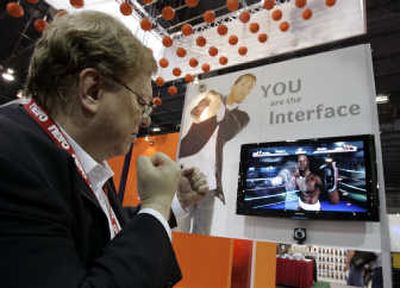Consumer electronics adding a personal touch

LAS VEGAS – Nintendo Corp.’s Wii game console is a breakout hit in large part because users control the play by waving around a motion-sensing wireless controller.
Many new gadgets are taking the idea of such an intuitive interface several steps further. Soon, you may be able to control computers, television sets, even cell phones with hand gestures alone.
In one demonstration by 3DV Systems at the International Consumer Electronics Show here this week, users stood in front of a large screen and controlled a Windows computer with hand gestures: thumb left to go left, index finger right to go right, victory sign for Enter.
JVC, also known as Victor Co. of Japan Ltd., demonstrated a prototype TV with controls based on the same idea: gestures and sounds like snaps and claps turn the set on or off, control volume or change the channel.
The prospect of never again having to search the sofa for a remote is sure to be welcome in many homes, but the traditional fight over the remote could become worse: Imagine two kids engaged in a sign-language duel to control the set, with the picture and sound changing frantically to keep up.
In another demo, when a 3DV employee did boxing motions an avatar on the screen in front of him mimicked the movement of his entire upper body – quite a step up from the boxing game of the Wii, which only senses the movement of the controllers.
A particularly popular Wii game is bowling, where the user swings the remote as if it were a ball. Two phones that hit the Japanese market in May include bowling games that work the same way, but without the Wii: Swing the whole cell phone and you launch the ball down the lane shown on the screen.
The motion-sensing technology in those phones comes from GestureTek, a Sunnyvale, Calif., company. While the Wii’s remote uses a combination of tiny mechanical springs and a camera to sense motion, GestureTek uses only cameras – quite conveniently, since most cell phones and quite a few laptops already come with cameras.
GestureTek’s technology is already found on some Verizon Wireless cell phones, which contain a game where the user can roll a ball through a maze by tilting the phone. Another application is the EyeToy for Sony Corp.’s PlayStation 2, which lets you play simple games by moving in front of the camera.
The technology isn’t just for fun: It can be healthy too. Francis MacDougall, GestureTek’s chief technology officer, said the company has run studies of stroke patients playing a snowboarding game by moving in front of a camera and found it improved their balance. Wiis also have been used for physical therapy.
To take these relatively simple applications further, GestureTek and 3DV are looking at adding a third dimension: depth. A regular camera produces a two-dimensional picture. Two cameras together can sense how far away an object is, just like two eyes enable humans to perceive depth.
“We think the interactivity of all this stuff improves with depth,” MacDougall said. “You can use that in very novel ways compared to 2-D.”
MacDougall demonstrated a prototype of the Airpoint, a foot-long bar with an upward-facing camera at either end. When MacDougall held his finger above it, it sensed the finger’s angle and position, letting him control a cursor on the computer screen by pointing.
“We see it initially as a gimmicky business-presentation type device, but you could see it built into the corners of a laptop,” MacDougall said. That approach would compete with touchscreen, but the Airpoint has something extra going for it: no fingerprints on the screen.
Reactrix Inc. makes commercial displays that you may have seen in movie-theater lobbies: an image projected on the floor that reacts to people walking on it. For instance, one of its Sprint ads let passers-by kick a football.
At the show, Reactrix demonstrated a depth-sensing system consisting of a display with a sensor and camera array above it. The system can sense and react to people up to 15 feet away waving at or pointing to objects on the screen. It will be on the market for commercial clients this summer.
3DV has another and quite exotic way of sensing depth that works with a single camera. The lens is surrounded by a ring of diodes emitting pulses of invisible infrared light, up to 60 per second. The light bounces off whoever is standing in front of the camera, and the camera measures when it comes back. Light reflected by closer objects returns faster.
“When light hits your nose, it gets back quicker than the light that hits your cheek,” 3DV spokesman Rich Flier said.
3DV plans to make its camera available to consumers by the end of the year, for less than $200, but it’s lacking a big-name manufacturer to build it into screens or bundle it with game consoles.
“We want people to play with the camera and develop applications,” Flier said. “We hope to see licensees pick it up.”